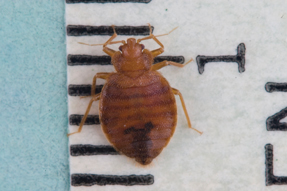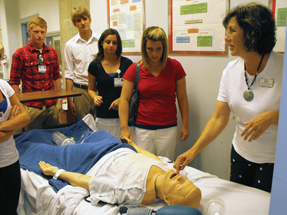Bed bug infestations can bring itchy, stressed patients
A surge in bed bug infestations leads internists to look for warning signs: not just rashes, but recent travel, confirmation by an exterminator, and bullous reactions.
“Don't let the bed bugs bite” is an old adage, but one that the American people are having increasing trouble following. In 2010, bed bugs, or Cimex lectularius, topped the list of problems faced by U.S. exterminators for the first time, more common than roaches and termites, said entomologist Rajeev Vaidyanathan, PhD, associate director of vector biology and zoonotic disease at nonprofit research institute SRI International.
Exterminators and entomologists are not the only experts being called upon to deal with the bed bug problem. Patients with unexplained itching, as well as those with more severe consequences of bed bug bites, may come to internists for help. The result is often misdiagnosis, experts say.

“Most of these people, doctors think they have psychosomatic problems on the first go-round,” said immunologist/rheumatologist Richard deShazo, MD, FACP.
The resurgence of bed bugs in the last several years took even experts by surprise. Dr. deShazo, a professor of medicine and pediatrics at the University of Mississippi Medical Center in Jackson, has since published several research papers about bed bugs, but he missed the first case to visit his office.
“[The patient] came into my clinic with this strange rash. He'd been seen by multiple physicians and nobody could figure out what was going on ... It was about five years ago,” Dr. deShazo said. The patient was a musician, and it turned out that he had picked up bed bugs while on tour in Europe, which is where the current U.S. epidemic may have originated.
A rash is a common clue to a bed bug diagnosis, but not a perfect one.
“It's sometimes difficult because the appearance of the bites is nonspecific,” said Stephen Hwang, MD, FACP, an associate professor of medicine and public health at the University of Toronto. “The reaction may be quite widespread urticaria in some patients who are sensitive, in others it might be a small pruritic papule, and in others it might be almost nothing.”
Even in cases where the bites leave no visible trace, patients may be feeling their effects. “If someone has a generalized dermatitis, chronic itching or if they wake up in the middle of the night itching, then you want to put this in your differential diagnosis,” said Dr. deShazo.
Recent travel is also a clue, since the bugs can be picked up in hotels. “The key questions to ask are, ‘Have you traveled recently?’ or ‘Have you been around someone who has traveled?’” said Dr. deShazo.
The only way to be absolutely certain of diagnosis is to spot a bug, which is rare in clinic. “Bed bugs are almost never found on the patient's body or clothing unless there's an extreme infestation in their home,” said Dr. Hwang.
Occasionally, patients may bring in a bed bug specimen, but typically, the next step is to send them home to inspect.
“If you have a bed bug infestation, any lay person can usually pick that up. All you have to do is go to bed, pull back your mattress cover and look along the cords of the mattress. You will see the bugs there. They are a little smaller than fleas and they defecate along the cord of the mattress blood that they have processed,” Dr. deShazo said.
Once a diagnosis is confirmed, the key referral is to the experts: exterminators. “The most important thing to do is to get a licensed, reputable pest control service to come in and provide advice,” said Dr. deShazo.
While the pest treatment is under way, medical treatment may be required as well.
“The treatment is symptomatic. Treat the itching. Make sure the lesions aren't infected,” said Dr. deShazo. “People scratch them and can claw their skin until they can get cellulitis.” Basic treatment includes over-the-counter or prescription agents such as topical paroxime or intermediate-potency corticosteroids or oral cetirizine or doxepin, while infections may require topical mupirocin or systemic antibiotics.
Other potential complications of bed bug bites are emerging in the literature. Dr. Hwang published a case study in the Canadian Medical Association Journal in 2009 about a patient whose unexplained anemia turned out to be the result of many, many bed bug bites.
This isn't a common occurrence, he noted. “The only time I think it can occur is when the person has a very severe infestation in their home, yet they are not reacting to it. We should be looking for this in individuals who are living in substandard housing and who are cognitively impaired, due to mental illness or developmental delay or other factors,” said Dr. Hwang.
Dr. deShazo is in the process of publishing data about a potentially more common complication: bullous reactions. “They're basically blisters that end up ulcerating,” he said.
When a colleague who was researching bed bugs developed the reaction, Dr. deShazo performed a biopsy and found vasculitis. “This is a significant problem because you basically necrose the skin where you've been bitten. It's the first time that we have known that these reactions actually have some real negative effects,” he said.
The bullous reactions are painful, persistent and potentially scarring, according to Dr. deShazo. “Those people need treatment with high-potency topical steroids on those lesions. If they are all over the body, they may actually require a short course of prednisone.”
The good news about the vasculitis is that it does not appear to become systemic. (Another reassuring research finding of Dr. deShazo's is that bed bugs do not appear to be spreading diseases such as HIV or hepatitis.)
However, bed bugs can have other insidious effects on patients. “Physicians should not underestimate the emotional distress and the mental health impact of having bed bugs. Even when the rash is mild or moderate, the bed bug infestation puts an incredible emotional stress on patients and it may drive them to despair, depression or panic,” said Dr. Hwang.
In the January 2012 American Journal of Medicine, Dr. deShazo and colleagues analyzed cases of post-traumatic stress disorder resulting from bed bug infestations. “Some folks have persistent fear of infestation even when they've had their area exterminated,” he said.
Patients suffering emotional effects may require mental health treatment or, at a minimum, some support and acknowledgment. “We should at least be open to discussing it with our patients, allowing them the chance to talk to us about it rather than just saying, ‘Oh, it's just a rash. Put this cream on,’” said Dr. Hwang.
Of course, in some cases, it really is just a rash. “With the increasing publicity around bed bugs, there are also patients who present with skin rashes that they think might be bed bugs but in fact are not. Sometimes we can reassure people that what they are showing us are very unlikely to be bed bug bites,” said Dr. deShazo.
Unfortunately, the likelihood of suffering a bed bug infestation is not expected to abate any time soon.”All of our larger cities have had these infestations or have them ongoing,” said Dr. deShazo. “This is a medical problem without an immediate solution.”
The heart of the problem appears to be bed bugs' increasing resistance to extermination strategies. “These bed bugs, which had been around since history was first recorded, have now become resistant to the pyrethrum insecticides that have been used for years to control them,” said Dr. deShazo.
Epidemiology research shows that U.S. bed bugs are becoming increasingly resistant, confirmed Kenneth Haynes, PhD, a professor of entomology at the University of Kentucky in Lexington. Researchers are hard at work looking for a solution that won't require going back to the extermination strategies of past eras.
“One of my favorites was to pack gunpowder in the seams around the bed and ignite it,” Dr. Haynes joked.





